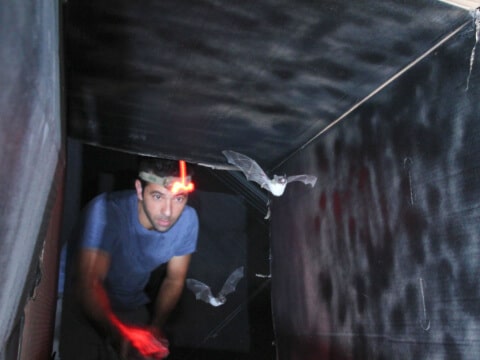Surprising discovery: bats know the speed of sound from birth * Meaning - the bat 'sees' an insect at a distance of nine milliseconds and not one and a half meters as thought until now

A new study by Tel Aviv University discovered for the first time in the world that bats know the speed of sound from birth. To prove this, the researchers raised bats from birth in a helium-enriched environment where the speed of sound is higher than normal and found that unlike humans who map the world in units of distance, the bats map the world in units of time. The meaning - the bat 'sees' an insect at a distance of nine milliseconds and not one and a half meters as thought until today.
To find their way around, bats use sonar - they produce sound waves that hit objects and are returned to the bat. The bats can "calculate" the position of the object in front of them based on the time that passes between the moment the sound wave is generated and the moment it is received back. This "calculation" depends a lot on the speed of sound which can change in different environmental conditions such as the composition of the air or the temperature. For example, there can be a difference of almost 10% between the speed of sound at the peak of heat in the summer season, when the air is warm and the sound waves spread faster, and the winter season. measure the speed of sound during their lifetime or are they born with a fixed value sense of sound speed?
Now, researchers led by former PhD student Dr. Eran Amichai and Prof. Yossi Yuval, head of the Segol School of Neuroscience and member of the School of Zoology, Faculty of Life Sciences, managed to answer this question. The researchers conducted an experiment where they could control the speed of sound. They enriched the composition of the air with helium to increase the speed of sound and raised bat pups from birth and adult bats under these conditions. Both the adult bats and the pups were unable to "calculate" the new speed of sound and always landed before the target, which indicates that they "perceived" the target as closer, i.e. did not adapt their behavior to the higher speed of sound.
Because this happens both in adult bats that learned to fly in normal environmental conditions and in pups that learned to fly in an environment with a higher than normal speed of sound, the researchers concluded that the value of sound speed in bats is an innate value - they have a constant sense of sound speed. "Because bats have to learn to fly shortly after they are born," explains Prof. Yuval, "we estimate that an evolutionary 'choice' was made here to be born with this knowledge in order to save time during the sensitive development period."
Another interesting conclusion of the study is that the bats do not actually calculate the distance to the target based on the speed of sound. Since they don't match the speed of sound encoded in their brains, they also don't seem to translate the time it takes for the sound waves to return to values of distance. Therefore, their spatial perception is probably based on time measurements and not on distance values.
Prof. Yossi Yuval: "What is most exciting for me in this research is that we were able to answer a very basic question - we discovered that bats do not actually measure distance, but time, in order to orient themselves in space. This may sound like a semantic difference, I think it means that their spatial perception is fundamentally different from that of humans and other visual creatures, at least when they rely on sonar. It's fascinating to see how diverse evolution is in the brain calculation strategies it produces."
More of the topic in Hayadan:

2 תגובות
Jonathan, it could be that the bat calculates in a 4-dimensional time-space field. That is, he sees units of time and not distance, which is essentially the same if we live in a four-dimensional time-space field.
I did not understand how they proved that their space is based on time and not on distance...
It could be that they calculate distance based on the time it takes - and the speed is a fixed figure...
After all, in the end he needs to know at what distance the target is from him - so there must be a distance calculation???